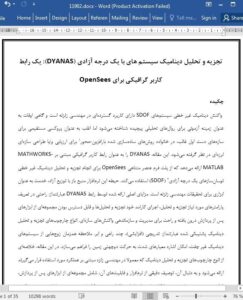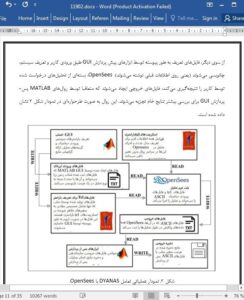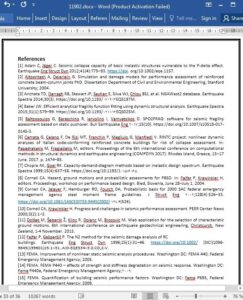Abstract
Non-linear dynamic response of SDOF systems enjoys widespread application in earthquake engineering, sometimes as a testing ground for cumbersome analytical procedures, but often as a direct proxy of first-mode-dominated structures, within the family of simplified, pushover-based methods for seismic structural assessment and/or design. This article presents DYANAS, a MATHWORKS-MATLAB®-based graphical user interface that uses the OpenSees finite element platform to perform nonlinear dynamic analysis of single-degree-of-freedom (SDOF) oscillators. The scope of this open-source, freely distributed software is to serve as a tool for earthquake engineering research. The main advantages offered by the DYANAS interface are ease in the definition of the required analysis parameters and corresponding seismic input, efficient execution of the analyses themselves and availability of a suite of convenient, in-built post-processing tools for the management and organization of the structural responses. The types of dynamic analysis frameworks supported are incremental, multiple-stripe and cloud. Simultaneous consideration of pairs of uncoupled dynamic systems gives the possibility for intensity measures to refer to bidirectional ground motion. In the paper, an outline of the types of dynamic analysis frameworks typically used in performance-based earthquake engineering is provided, followed by a detailed description of the software and its capabilities, that include an array of post-processing tools. In order to properly place this software tool within its natural performance-based earthquake engineering habitat, some example applications are provided at the end of the paper.
5. Concluding remarks
This article was dedicated to the presentation of DYANAS, an opensource, earthquake engineering software. The software is a MATHWORKS MATLAB® -based graphical user interface that interacts with the OpenSees finite element framework and offers engineers an easy way to define and run dynamic analysis of yielding single-degree-of-freedom systems subjected to large suites of earthquake-induced ground motion records. Therefore, the main purpose of this software is to determine the relationship between seismic intensity and engineering demand parameters using any one of several dynamic analysis methods that are frequently used in performance-based earthquake engineering. Incremental dynamic analysis is supported in its traditional form and also in a “back-to-back” format that could allow state-dependent seismic fragility to be estimated. Multiple-stripe and cloud-type analyses are also supported, in cases where the user does not desire to use scaled records to estimate seismic response at different levels of shacking intensity. Much of the software’s utility stems from the postprocessing routines, with which it is equipped. These routines, which are also programmed in MATLAB and can be recalled via the user interface, permit the re-interpolation of incremental dynamic analysis curves, thus providing rapid conversion of the curves into alternative intensity measures, such as peak ground acceleration or spectral ordinates at various periods. Furthermore, at the end of analysis, the user can obtain vectors of intensity measure given engineering demand parameter, or vice versa, thus facilitating further probabilistic seismic demand elaborations for these simple structural systems. Overall, the GUI was shown to be a useful tool within the context of performancebased earthquake engineering, as demonstrated by the illustrative applications provided. DYANAS is freely distributed for research purposes by the University of Naples Federico II under a GNU general public license v3.0, obtainable at http://wpage.unina.it/georgios. baltzopoulos/software/dyanas.zip. The MATLAB and Tcl/Tk source code is available at a dedicated GitHub repository at https://github. com/georgebaltz/SDOF-OSEES.











